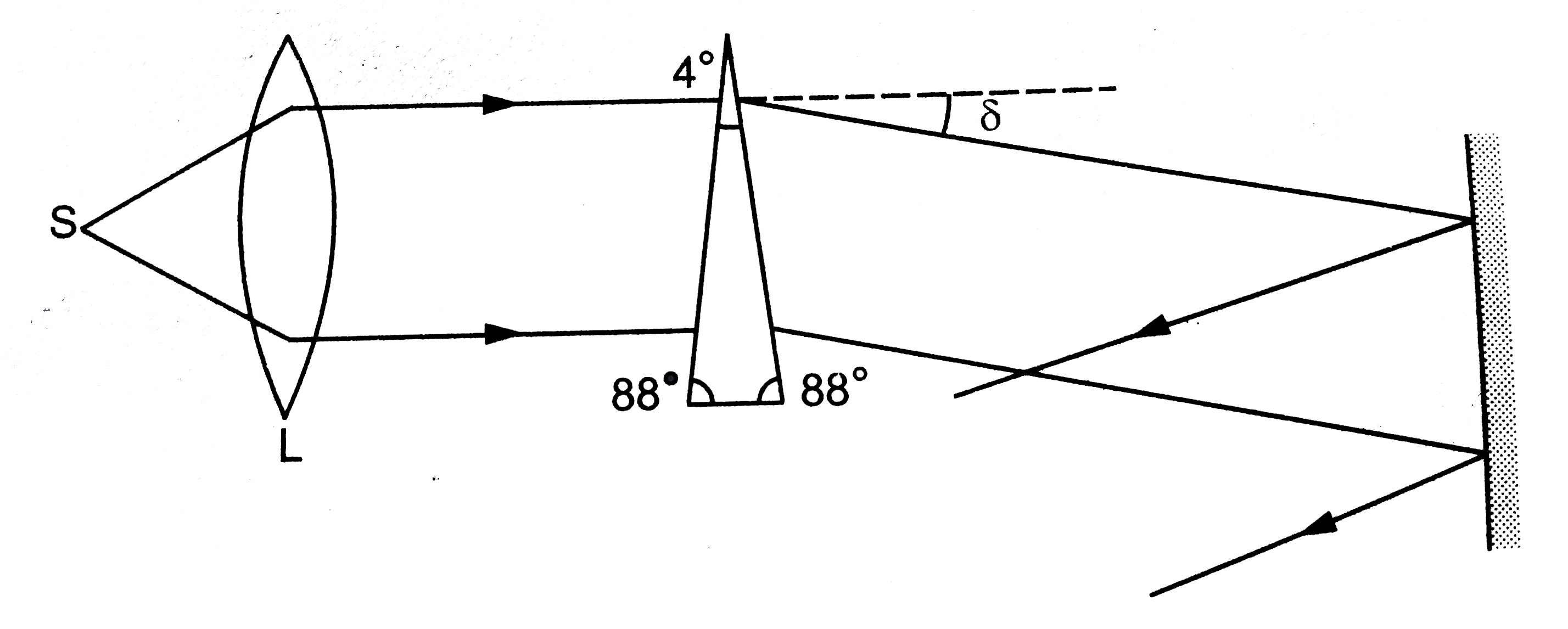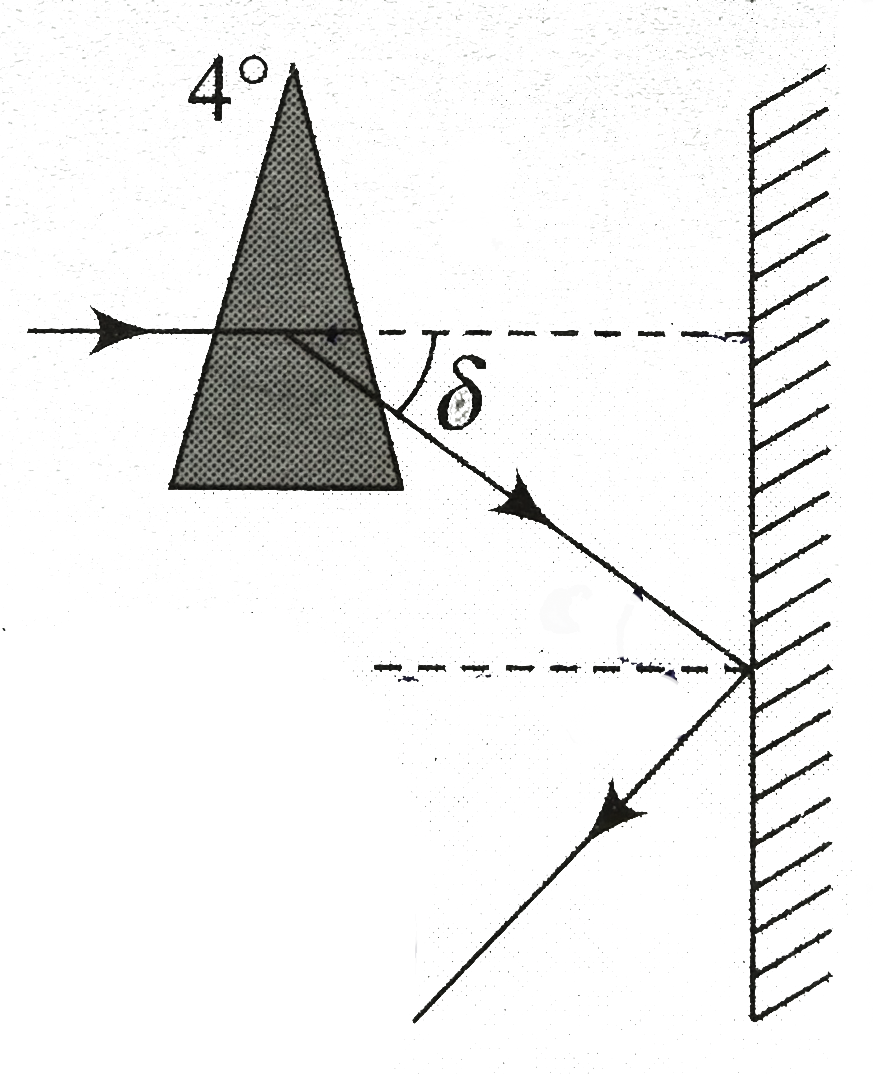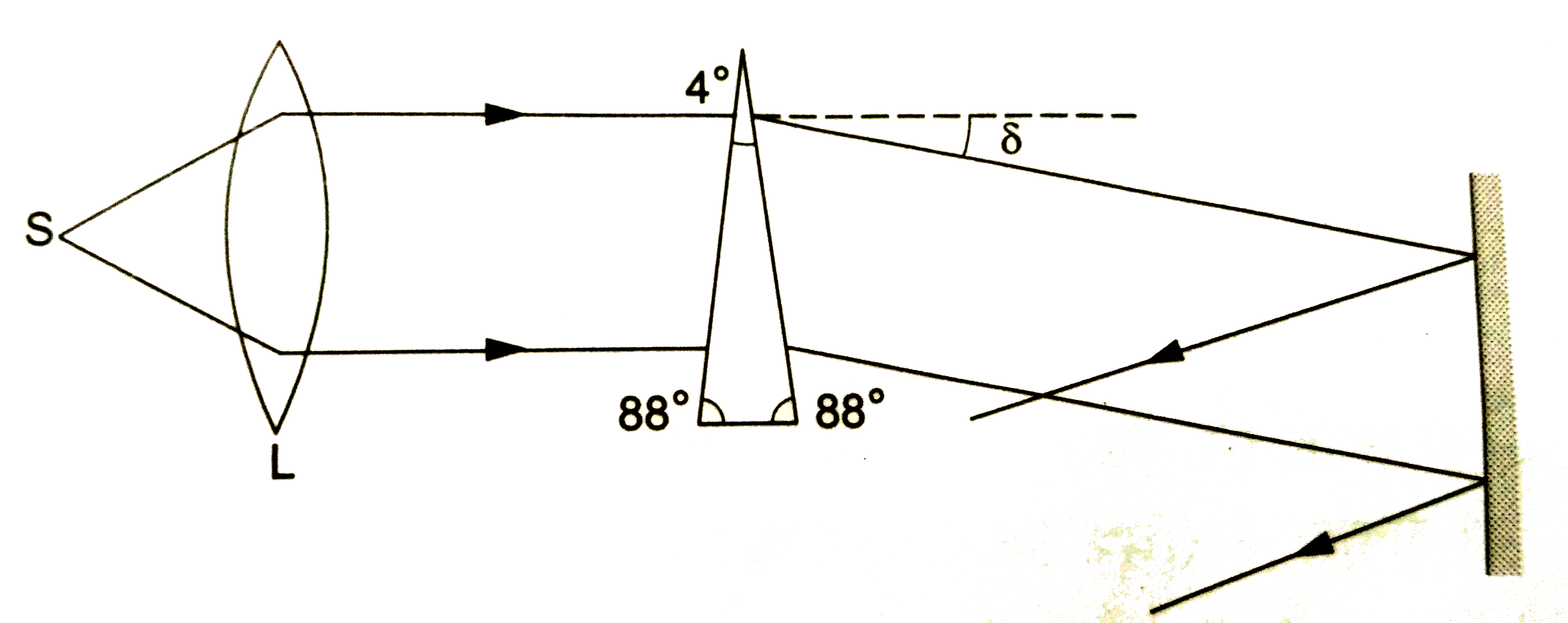Consider the situation shown in figure. Light from a point source S is made parallel by a convex lens L. The beam travels horizontally and falls on an prism as shown in figure. It passes through the prism symmetrically. The transmitted light falls on a vertical mirror. Through what angle should the mirror be rotated so that an image of S is formed on S itself?
 Solution in Tamil
Solution in Tamil
The parallel beam after going through the prism will be deviated by an angle . If the mirror is also rotated by this angle . The rays will fal normally on it. The rays will be reflected back along the same path and form the image of S on itself.
as the prismis thin, the angle is given by
thus , the mirror should be rotated by
Topper's Solved these Questions
- BOOK - HC VERMACHAPTER - GEOMETRICAL OPTICSEXERCISE - Question For short Answer19videos
GEOMETRICAL OPTICS
- BOOK - HC VERMACHAPTER - GEOMETRICAL OPTICSEXERCISE - Objective -118videos
GEOMETRICAL OPTICS
- BOOK - HC VERMACHAPTER - GEOMETRICAL OPTICSEXERCISE - Exercises79videos
GEOMETRICAL OPTICS
- BOOK - HC VERMACHAPTER - GAUSS LAWEXERCISE - Exercises24videos
GAUSS LAW
- BOOK - HC VERMACHAPTER - LIGHT WAVESEXERCISE - Exercises41videos
LIGHT WAVES
Similar Questions
Is the formula "Real depth/Apparent depth =μ. valid if viewed from a position quite away from the normal ?
04:02View SolutionA point source of light is placed in front of a plane mirror.
05:08View SolutionA concave mirror having a radius of curvature 40 cm is placed in front of an illuminated point source at a distance of 30 cm from it. Find the location of the image.
02:35View SolutionThe electric field in a region is given by →E=35E0→i+45E0→j with E0=2.0×103NC−1. Find the flux of this field through a recatngular surface of area 0.2m2 parallel to the y-z plane.
02:24View SolutionFind the range of frequency of light that is visible to an average human being (400nm<λ<700nm)
02:26View SolutionA plane mirror is falling vertically as ssshown in the figure. If S is a point source of light, the rate of increase of the length AB is
01:52View SolutionA small angled prism of apex angle A=4^@ and refractive index mu=1.5 is placed in front of a vertical plane mirror as shown in figure. If the mirror is rotated through an angle theta, then the light ray becomes horizontal either after the mirror or after second time passing from the prism in opposite direction. The value theta is
05:07View SolutionA horizontal ray of light passes through a prism whose apex angle is 4∘ and then strikes a vertical mirror M as shown in Figure. For the ray to become horizontal after reflection, Find the angle by which the mirror must be rotated.
 02:09View Solution
02:09View SolutionFor the situations shown in figure, determine the angle by which the mirror should be rotated, so that the light ray will retrace its path after refraction through the prism and reflection from the mirror?
View SolutionA prism having an apex angle of 4^@ and refractive index of 1.50 is located in front of a vertical plane mirror as shown in the figure. A horizontal ray of light is incident on the prism. The total angle through which the ray is deviated is:
03:10View SolutionA horizontal ray of light passes through a prism of index 1.50 and apex angle 4∘ and then strikes a vertical mirror , as shown in the figure. Through what angle must the mirror be rotated if after reflection the ray is to be horizontal?
_E01_041_Q01.png) 08:21View Solution
08:21View Solutionएक बिंदु स्रोत S से चलता प्रकाश एक उत्तल लेंस से निकलकर एक क्षैतिज बीम के रूप में आगे बढ़ता है (चित्र 34.W13) यह बीम एक 88∘−88∘−4∘ कोण वाले प्रिज्म पर सममित रूप से पड़ती है और अपवर्तन के पश्चात यह बीम एक समतल दर्पण पर पड़ती है जिसका तल लेंस से निकलती बीम के लंबवत है। दर्पण को कितने कोण से गुमा जाए ताकि S का अंतिम प्रतिबिंब S पर ही बने ?
 01:48View Solution
01:48View SolutionA beam of beam AO falls on a glass block (n = 1.54) as shown in the figure. The reflected ray OB passes through a nickel prism. Looking through the prism, we see that on rotating the prism
03:18View SolutionAs shown in the figure , a parallel beam of light incidents on the upper part of a prism of angle 1.8∘ and material pf refractive index 1.5 . The light emerging out from the prism falls on a convature 40 cm. This distance of the point from the principal axis of the mirror where the light rays are focussed after reflection from the mirror is
 02:31View Solution
02:31View SolutionA plane mirror is falling vertically as ssshown in the figure. If S is a point source of light, the rate of increase of the length AB is
03:09View SolutionA small angled prism of apex angle A=4^@ and refractive index mu=1.5 is placed in front of a vertical plane mirror as shown in figure. If the mirror is rotated through an angle theta, then the light ray becomes horizontal either after the mirror or after second time passing from the prism in opposite direction. The value theta is
01:02View Solution

